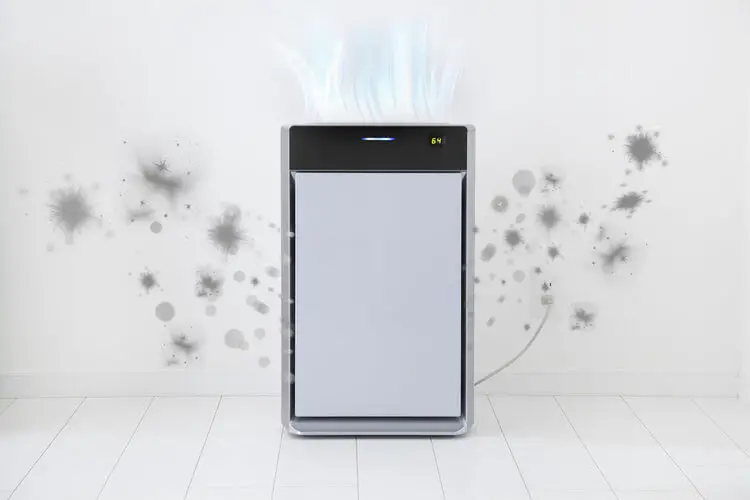Are you concerned about mold in your home and looking for ways to get rid of mold spores in the air?
You won’t see mold spores in the air—but you might become aware of their presence if you’re having itchy eyes or sneezing. You might be allergic to mold or have a condition like asthma that could be exacerbated by it.1
Let’s take a look at the signs that you have mold in your home—and then go through some ways to get rid of mold spores.
Key Signs of Mold in Your Home
Mold tends to grow in warm, damp, humid environments.2 You might detect mold in your home by:
- Smelling it. That old, musty smell is a real giveaway. You might notice it on wet towels that haven’t been left to dry out properly. You may also find that the musty smell hits you when you walk into certain rooms—or even when you re-enter your house after spending some time out of it. (When you’re surrounded by the smell, you’re less likely to notice it.)
- Seeing it. You may have visible mold in damp areas of your home, such as on the bathroom walls, on the ceilings (particularly in the corners) or even on furniture. Mold can come in a range of colors, but green, black, and brown shades tend to be the most common.3
While you won’t be able to completely eradicate every mold spore from the air—they’re just part of nature—a high concentration of mold spores can cause health problems. And if you can smell or see mold, there’s a good chance that you have too many mold spores in the air within your house.
Here’s what you can do about it.
1. Clean Up Visible Mold
If you have any visible mold in your home, clean it up. You can scrub mold from hard surfaces, such as tiles, using detergent and water. You should then dry these completely. 4
You can also use white vinegar to attack mold. Regular white vinegar contains around 5 to 8 percent acetic acid. This has a pH of around 2.5 5, meaning it’s a strong acid that can kill mold.
Before you start cleaning, make sure that you protect yourself from contact with the mold. Wear gloves and consider also wearing an N-95 respirator and goggles.

Image courtesy of Pexels
2. Air Damp Towels and Wash Them Regularly
To prevent mold from growing in towels, make sure you let them dry completely between uses. Hang up wet towels so that they dry as quickly as possible—don’t leave them folded up in the bathroom.
If your bathroom is very humid, you might want to take towels out and air them elsewhere: ideally outside or in a well-ventilated room.
If you notice a moldy smell on a towel, it needs washing: don’t leave it in your bathroom for reuse.
3. Ventilate Your Home
The key to preventing mold growth is to reduce moisture levels in your home. Keeping windows open and turning on extractor fans helps to lower the humidity in your home and brings in fresh air.
If your home is poorly ventilated, you might want to consider installing extra fans to circulate the air throughout your rooms. In general, increased ventilation is associated with better health. 6

Image courtsey of Pixabay
4. Use an Air Purifier for Mold
To get as many mold spores out of the air in your home as possible, you should use an air purifier for mold. These can reduce the number of airborne mold spores in your home by up to 6 times faster than they would decrease naturally. 7
There are lots of different models of air purifiers available, so you should be able to find one to suit your household budget. Think carefully about the room you want to use the air purifier in, too: e.g. if you want to use one in your bedroom, you’ll want to pick a model that’s as quiet as possible.
5. Wipe Down Your Bathroom After a Shower
After showering, you’ll have water on the tiles and shower curtain. It’s important to remove this water as quickly as possible, rather than simply leaving it to drip and dry on its own.
A simple squeegee lets you remove water spots from tiles and shower doors, as well as from windows and mirrors. As well as helping to prevent mold growth in your bathroom, it’ll help keep your bathroom looking shiny and clean—as you won’t have water spots and smears.
Encourage family members or roommates to get into the habit of wiping down tiles and other surfaces after showering, too.
To get rid of mold spores in the air, you need to get rid of the source of the mold—you can’t simply treat the air itself. By ensuring that your home is kept dry and that mold is cleaned up quickly, you’ll soon see a huge improvement in the air quality inside your home.
Article Sources
Healing Daily uses only high-quality sources, including peer-reviewed studies, to support the facts within our articles. Read our editorial process to learn more about how we fact-check and keep our content accurate, reliable, and trustworthy.
- Bush RK, Portnoy JM, Saxon A, Terr AI, Wood RA. The medical effects of mold exposure [published correction appears in J Allergy Clin Immunol. 2006 Jun;117(6):1373] [published correction appears in J Allergy Clin Immunol. 2014 Nov;134(5):1217]. J Allergy Clin Immunol. 2006;117(2):326-333. doi:10.1016/j.jaci.2005.12.001
- MedlinePlus. Molds. MedlinePlus website. Accessed 30 September 2021.
- Mold Inspectors of Florida. The Rainbow Colors of Mold. Mold Inspectors of Florida. Accessed 30 Sept 2021.
- United States Environmental Protection Agency. What are the basic mold cleanup steps? Epa.gov. Accessed 30 Sept 2021.
- Cortesia C, Vilchèze C, Bernut A, et al. Acetic Acid, the active component of vinegar, is an effective tuberculocidal disinfectant. mBio. 2014;5(2):e00013-e14. Published 2014 Feb 25. doi:10.1128/mBio.00013-14
- Fisk WJ. How home ventilation rates affect health: A literature review. Indoor Air. 2018;28(4):473-487. doi:10.1111/ina.12469
- Hashimoto K, Kawakami Y. Effectiveness of Airborne Fungi Removal by using a HEPA Air Purifier Fan in Houses. Biocontrol Sci. 2018;23(4):215-221. doi:10.4265/bio.23.215



